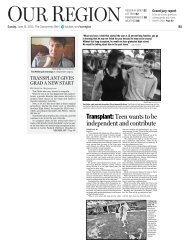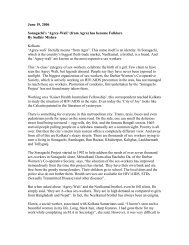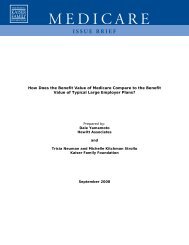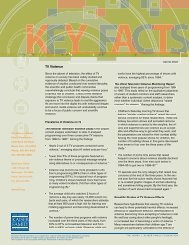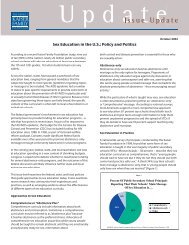HEALTH CARE COSTS: A PRimER - The Henry J. Kaiser Family ...
HEALTH CARE COSTS: A PRimER - The Henry J. Kaiser Family ...
HEALTH CARE COSTS: A PRimER - The Henry J. Kaiser Family ...
You also want an ePaper? Increase the reach of your titles
YUMPU automatically turns print PDFs into web optimized ePapers that Google loves.
Why Are Health Care Costs Growing Faster Than the Economy Overall?<br />
As shown in Figure 1, the portion of the economy devoted to health care has risen steadily<br />
for at least 50 years, rising from 5.2% of GDP in 1960 to 17.9% of GDP in 2010. CMS<br />
estimates that nearly one-fifth (19.8%) of GDP will be devoted to health care by the year<br />
2020. 22 Although recent increases in health care spending have declined relative to<br />
increases in the GDP, the questions still remains -- why does spending on health care grow<br />
faster than overall economic growth? 23<br />
Wealthier countries can afford to spend more on health care technologies. Studies<br />
looking at the United States and other economies have found a strong correlation between<br />
wealth and health care spending – as nations become wealthier, they chose to spend more<br />
of their wealth on health care. 24 Nations can spend more because the health care<br />
community continues to learn more every day about human health and health care<br />
conditions and, with that knowledge, is constantly expanding the inventory of health care<br />
products, techniques, and services that are available to address those conditions. Health<br />
care experts point to the development and diffusion of medical technology as primary<br />
factors in explaining the persistent difference between health spending and overall<br />
economic growth, with some arguing that new medical technology may account for about<br />
one-half or more of real long-term spending growth. 25<br />
<strong>The</strong> U.S. population is getting older and disease prevalence has changed. Other<br />
factors also influence spending growth. <strong>The</strong> U.S. population is aging (CBO estimates that<br />
the number of people age 65 or older will increase by about one-third between 2012 and<br />
2022), and because older people have more health problems and use more health care<br />
than younger people, population aging will have a small but persistent impact on cost<br />
growth in the years to come. 26<br />
<strong>HEALTH</strong> <strong>CARE</strong> <strong>COSTS</strong>: KEY INFORMATION ON <strong>HEALTH</strong> <strong>CARE</strong> <strong>COSTS</strong> AND THEIR IMPACT<br />
Increases in disease prevalence, particularly chronic<br />
diseases such as diabetes, asthma, and heart disease, coupled with the growing ability of<br />
the health system to treat the chronically ill, contribute to the high and growing levels of<br />
health spending. Rising obesity levels are another factor which may be influencing cost<br />
growth, but other trends, such as lower levels of smoking and alcohol consumption, may<br />
have a moderating effect. 27 A small share of the population accounts for a high proportion<br />
of costs (see Figure 5). Developments in medicine and medical technology enable people<br />
who otherwise might have died to live longer, though perhaps with chronic conditions such<br />
as cancer or HIV/AIDS which require ongoing medical care.<br />
Insurance coverage has increased. Government subsidies for health coverage also<br />
affect cost levels and potentially cost growth. Tax subsidies for health insurance and public<br />
coverage for certain groups (poor, disabled, and elderly) reduce the cost of health care to<br />
individuals, encouraging them to use more of it. Some argue that the high prevalence of<br />
health insurance encourages health technology development because those developing<br />
new technologies know that insurance will bear a substantial share of any new costs. 28<br />
Americans pay a lower share of health expenses than they used to. Another factor<br />
that may help explain rising health spending is the falling share of health care expenditures<br />
that Americans pay out-of-pocket. 29 Between 1970 and 2010, the share of personal health<br />
expenditures paid directly out-of-pocket by consumers fell from 40% to 14%. Although<br />
consumers faced rising health insurance premiums over the period which affected their<br />
budgets, lower cost sharing at the point of service likely enabled consumers to use more<br />
health care, leading to expenditure growth.<br />
25



